Sensitization of ASIC3 by proteinase-activated receptor 2 signaling contributes to acidosis-induced nociception
- PMID: 28754162
- PMCID: PMC5534107
- DOI: 10.1186/s12974-017-0916-4
Sensitization of ASIC3 by proteinase-activated receptor 2 signaling contributes to acidosis-induced nociception
Abstract
Background: Tissue acidosis and inflammatory mediators play critical roles in pain. Pro-inflammatory agents trypsin and tryptase cleave and activate proteinase-activated receptor 2 (PAR2) expressed on sensory nerves, which is involved in peripheral mechanisms of inflammation and pain. Extracellular acidosis activates acid-sensing ion channel 3 (ASIC3) to trigger pain sensation. Here, we show that a functional interaction of PAR2 and ASIC3 could contribute to acidosis-induced nociception.
Methods: Electrophysiological experiments were performed on both rat DRG neurons and Chinese hamster ovary (CHO) cells expressing ASIC3 and PAR2. Nociceptive behavior was induced by acetic acid in rats.
Results: PAR2-AP, PAR2-activating peptide, concentration-dependently increased the ASIC3 currents in CHO cells transfected with ASIC3 and PAR2. The proton concentration-response relationship was not changed, but that the maximal response increased 58.7 ± 3.8% after pretreatment of PAR2-AP. PAR2 mediated the potentiation of ASIC3 currents via an intracellular cascade. PAR2-AP potentiation of ASIC3 currents disappeared after inhibition of intracellular G protein, PLC, PKC, or PKA signaling. Moreover, PAR2 activation increased proton-evoked currents and spikes mediated by ASIC3 in rat dorsal root ganglion neurons. Finally, peripheral administration of PAR2-AP dose-dependently exacerbated acidosis-induced nocifensive behaviors in rats.
Conclusions: These results indicated that PAR2 signaling sensitized ASIC3, which may contribute to acidosis-induced nociception. These represent a novel peripheral mechanism underlying PAR2 involvement in hyperalgesia by sensitizing ASIC3 in primary sensory neurons.
Keywords: Acid-sensing ion channel 3; Dorsal root ganglion neuron; Nociception; Proteinase-activated receptor 2; Proton-gated current.
Conflict of interest statement
Ethics approval and consent to participate
The experimental protocol was approved by the animal research ethics committee of Hubei University of Science and Technology (No. 2016–67).
Consent for publication
Not applicable.
Competing interests
The authors declare that they have no competing interests.
Publisher’s Note
Springer Nature remains neutral with regard to jurisdictional claims in published maps and institutional affiliations.
Figures
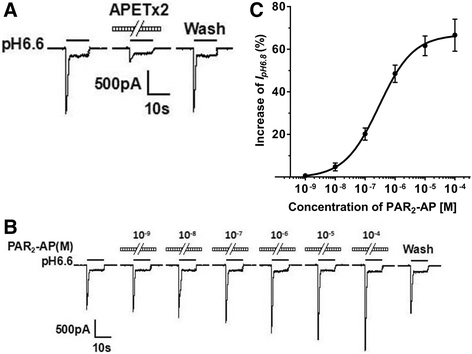
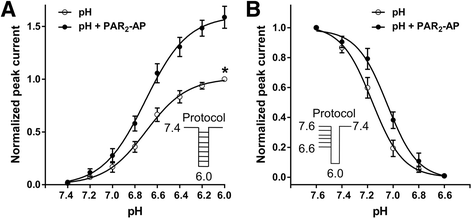
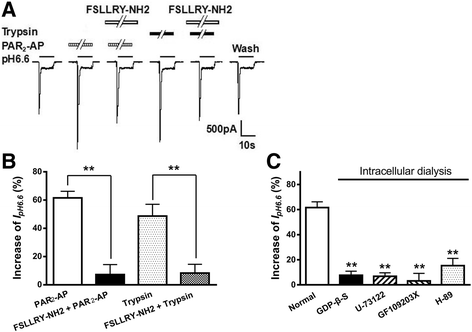

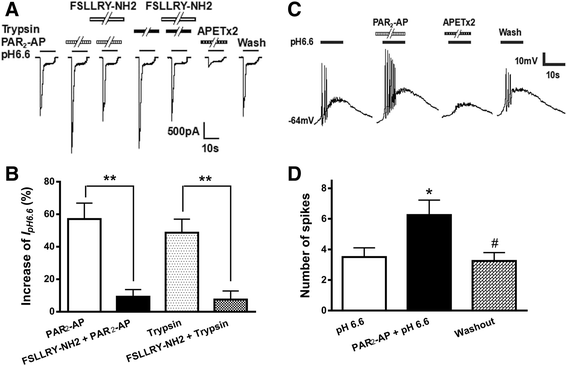
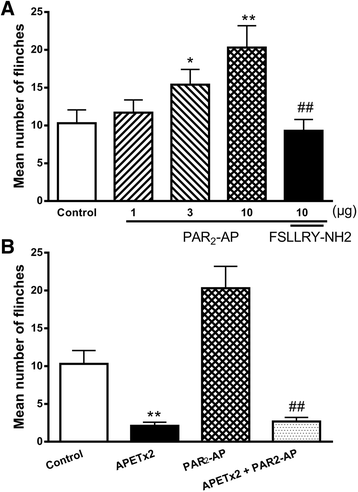
Similar articles
-
Potentiation of acid-sensing ion channel activity by peripheral group I metabotropic glutamate receptor signaling.Pharmacol Res. 2016 May;107:19-26. doi: 10.1016/j.phrs.2016.02.018. Epub 2016 Mar 3. Pharmacol Res. 2016. PMID: 26946972
-
Enhancement of acid-sensing ion channel activity by prostaglandin E2 in rat dorsal root ganglion neurons.Brain Res. 2019 Dec 1;1724:146442. doi: 10.1016/j.brainres.2019.146442. Epub 2019 Sep 9. Brain Res. 2019. PMID: 31513790
-
Endothelin-1 enhances acid-sensing ion channel currents in rat primary sensory neurons.Acta Pharmacol Sin. 2020 Aug;41(8):1049-1057. doi: 10.1038/s41401-019-0348-z. Epub 2020 Feb 27. Acta Pharmacol Sin. 2020. PMID: 32107467 Free PMC article.
-
ASIC3 channels in multimodal sensory perception.ACS Chem Neurosci. 2011 Jan 19;2(1):26-37. doi: 10.1021/cn100094b. Epub 2010 Nov 12. ACS Chem Neurosci. 2011. PMID: 22778854 Free PMC article. Review.
-
Roles of ASICs in Nociception and Proprioception.Adv Exp Med Biol. 2018;1099:37-47. doi: 10.1007/978-981-13-1756-9_4. Adv Exp Med Biol. 2018. PMID: 30306513 Review.
Cited by
-
PPAR-α acutely inhibits functional activity of ASICs in rat dorsal root ganglion neurons.Oncotarget. 2017 Oct 10;8(54):93051-93062. doi: 10.18632/oncotarget.21805. eCollection 2017 Nov 3. Oncotarget. 2017. PMID: 29190977 Free PMC article.
-
ASIC3 inhibition modulates inflammation-induced changes in the activity and sensitivity of Aδ and C fiber sensory neurons that innervate bone.Mol Pain. 2020 Jan-Dec;16:1744806920975950. doi: 10.1177/1744806920975950. Mol Pain. 2020. PMID: 33280501 Free PMC article.
-
Update on protease-activated receptor 2 in inflammatory and autoimmune dermatological diseases.Front Immunol. 2024 Sep 19;15:1449126. doi: 10.3389/fimmu.2024.1449126. eCollection 2024. Front Immunol. 2024. PMID: 39364397 Free PMC article. Review.
-
Postoperative pain pathophysiology and treatment strategies after CRS + HIPEC for peritoneal cancer.World J Surg Oncol. 2020 Mar 31;18(1):62. doi: 10.1186/s12957-020-01842-7. World J Surg Oncol. 2020. PMID: 32234062 Free PMC article. Review.
-
Insulin enhances acid-sensing ion channel currents in rat primary sensory neurons.Sci Rep. 2024 Aug 5;14(1):18077. doi: 10.1038/s41598-024-69139-3. Sci Rep. 2024. PMID: 39103432 Free PMC article.
References
-
- Hollenberg MD, Renaux B, Hyun E, Houle S, Vergnolle N, Saifeddine M, Ramachandran R. Derivatized 2-furoyl-LIGRLO-amide, a versatile and selective probe for proteinase-activated receptor 2: binding and visualization. J Pharmacol Exp Ther. 2008;326:453–462. doi: 10.1124/jpet.108.136432. - DOI - PubMed
MeSH terms
Substances
LinkOut - more resources
Full Text Sources
Other Literature Sources
Medical

